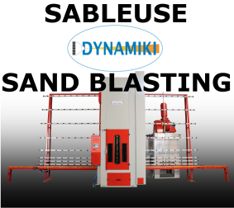Why use refrigerant in water tanks?
Take the next test. Note the level of the amperage of the diamond pins on your straight, without refrigerant, then start adding a little refrigerant while your rectilinear shapes the glass. You will quickly notice that the amperage level is decreasing, proof that the demand for power to the pins is lower and therefore that the shaping is done more efficiently.
The break-in of the glass by the diamond grinding wheels raises the temperature of the glass and grinding stones by several hundred degrees. It is therefore imperative to reduce this temperature to eliminate the risk of breakage of the glass and faster wear of the grinding wheels. Usually the cooling is done by injection of water on contact with glass grinding wheels in the compartments of the grinding wheels.
Below you will find an article written about it by one of the world's leading specialists in this field.
Flat glass shaping: Synthetic coolants improve the break-in of glass.
When shaping flat glass with diamond tools the use of synthetic coolants (without mineral oils) offers many advantages. In this article, Dr. Michael Emonds * provides specific insights into the process of glass break-in, gives the different characteristics of coolants and how they improve the effectiveness of lapping and drilling.
Coolants can be classified in relation to their behavior with water. While mineral oil coolants are not water soluble, synthetic coolers are, which will increase their efficiency. They consist of a mixture of organic and inorganic products without any addition of mineral oils.
The different functions of a modern synthetic coolant.
Primary and secondary functions can be distinguished.
The main characteristic of a coolant is to lower the temperature of the tool and glass during shaping, to reduce friction, to facilitate the removal of glass and to move the removed glass particles out of the air. shaping area (glass contact and tool).
The secondary functions have an influence on the operation of the machine. A coolant can for example help to fight against corrosion, stabilize the pH and act on the shaping residues (silica, generated by the abrasion of the glass by the diamond tool).
Drilling or prowling the glass means working on a fragile material with diamond tools. This material removal system requires a means for lowering the temperature and moving away waste generated by shaping the work area. The oil is often used for such an operation. However, arguments can be made in favor of water.
But meeting today the imperatives of quality and productivity using only water is not possible. Coolant must be added. This product consists of different components that bring various characteristics to the product. Surfactants for example lubricate the contact between the tool and the material and give better wettability to the removed glass particles. Other organic or inorganic additives fight against corrosion and act as a biocide or stabilize ph (buffer solutions). Additives often have many of these functions.
Functions of surfactants
Surfactants are products that are very often present in products used daily for cleaning. The same type of molecules is present in modern coolants.
Chemically surfactants are long hydrophobic chains with hydrophilic ends. The ends of the molecules inter-react with the water and the hydrophobic part reacts with the mineral oils or residues. Due to this composition, the hydrophobic parts are rendered soluble in water.
Influence of refrigerant concentration and water quality
Influence of the refrigerant concentration on the work of the diamond grinding wheels during the shaping of the flat glass, also taking into account the hardness of the water
The refrigerant is to be compared to a cutting oil in mechanics, one of whose main objectives is to cool during shaping (contact of the tool with glass) glass and grinding wheel.
Refrigerants on the market also include additives with other functions but not directly related to the work of the tool.
Results of tests performed on Bovone 371 beveler by varying the percentages of oil, the hardness of the water
- In case of fresh water (<25 ° F) the concentration of the cutting oil (refrigerant) continuously influences the work of the 1st grinding wheel. The decrease of the amperage compared to a 1% increase of the oil is equal to 0.3 A.
- In case of hard water (32 ° F) the cutting oil continuously influences the work of the first two grinding wheels much more important than in the previous case. The decrease in amperage compared to a 1% increase in oil is equal to 0.6 A.
- Considering 2% of oil and increasing the hardness of the water, the absorption increases only on the 1st millstone until the hardness of 40 ° F approximately, above which the amperage (which allows measure the power demanded from the grinding wheel) remains constant.
- In the absence of oil, by increasing the hardness of the water, ammeters increase linearly.
- Therefore it is deduced that in the presence of fresh water the increase in the oil concentration results in a reduction of the amperage with an absolute value much less important than everything that has been verified in the presence of water with hardness above 40 ° F. So, in the case of amperage problems, first check the hardness of the water. In case of high hardness, the percentage of cutting oil added to the water of the tanks will have to increase more than in the case of fresh water.
Edge quality based on working speed and coolant concentration.
On a drill Bystronic PBM 97 holes were made with a forest Wendt Boart drill DB
FC 191 and the quality of the edge has been controlled by a graphics software.
By increasing the piercing speed the quality of the edge decreases. But with 4% coolant the quality of the edge of the hole is better than using just water.
An additional increase in coolant concentration increases quality again especially at high cutting speed









